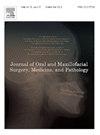药物相关性颌骨骨坏死继发于种植体周围炎:一个独特临床过程的病例报告
IF 0.4
Q4 DENTISTRY, ORAL SURGERY & MEDICINE
Journal of Oral and Maxillofacial Surgery Medicine and Pathology
Pub Date : 2024-12-12
DOI:10.1016/j.ajoms.2024.12.009
引用次数: 0
摘要
有全身性疾病的老年人接受植牙治疗的人数正在增加。种植体周围炎是与药物相关性颌骨骨坏死(MRONJ)相关的局部因素。严重MRONJ伴病理性骨折的治疗方法仍存在争议。一位86岁的老年痴呆和骨质疏松症妇女被转介到我科,主诉左下颌种植体周围炎。我们诊断她的MRONJ继发于种植体周围炎,并进行了保守手术,完全切除了附着体。尽管术后约2个月发生病理性骨折,但由于偏差最小且无活动性炎症,我们对患者进行了保守观察。术后约1年发生骨再生。我们的研究结果表明,在接受抗吸收治疗的老年痴呆患者中,应该仔细监测种植体,以防止种植体周围炎和种植体周围MRONJ。对于严重MRONJ和病理性骨折的患者,如果剩余骨具有重塑能力,保守手术可以获得良好的骨愈合。本文章由计算机程序翻译,如有差异,请以英文原文为准。
Medication-related osteonecrosis of the jaw secondary to peri-implantitis: Report of a case with a unique clinical course
The number of older adults with systemic conditions who have undergone dental implant treatment is increasing. Peri-implantitis is a local factor associated with medication-related osteonecrosis of the jaw (MRONJ). Treatment methods for severe MRONJ with pathological fracture remain controversial. An 86-year-old woman with dementia and osteoporosis was referred to our department with a chief complaint of left mandibular peri-implantitis. We diagnosed her with MRONJ secondary to peri-implantitis and performed conservative surgery in which the sequestrum was completely excised. Although a pathological fracture occurred approximately 2 months after surgery, we observed the patient conservatively because of the minimal deviation and absence of active inflammation. Spontaneous bone regeneration had occurred by approximately 1 year postoperatively. Our findings suggested that dental implants placed in older adults with dementia who are receiving antiresorptive therapy should be carefully monitored to prevent peri-implantitis and peri-implant MRONJ. In patients with severe MRONJ and pathological fracture, favorable bone healing can be achieved with conservative surgery if the remaining bone has remodeling capability.
求助全文
通过发布文献求助,成功后即可免费获取论文全文。
去求助
来源期刊

Journal of Oral and Maxillofacial Surgery Medicine and Pathology
DENTISTRY, ORAL SURGERY & MEDICINE-
CiteScore
0.80
自引率
0.00%
发文量
129
审稿时长
83 days
 求助内容:
求助内容: 应助结果提醒方式:
应助结果提醒方式:


